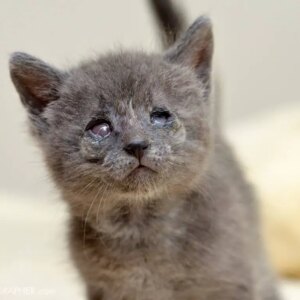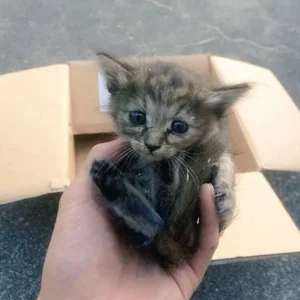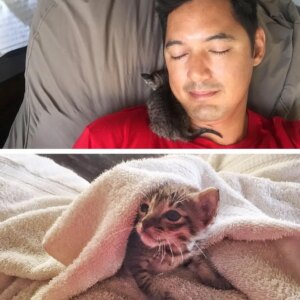You may have heard the saying, ‘You are what you eat,’ and this rings true not only for humans but also for our feline companions. The food we feed our cats plays a crucial role in their health and well-being. One option that has gained popularity is a raw cat food diet, which involves feeding your cat uncooked meat, bones, and organs. While this diet can have its benefits, there are also potential risks to consider.
Before deciding whether a raw cat food diet is right for your furry friend, it’s important to weigh the pros and cons. On one hand, proponents of this diet argue that it more closely mimics what cats would eat in the wild and provides them with essential nutrients without fillers or preservatives.
However, on the other hand, opponents warn of potential bacterial contamination from handling raw meat and bones as well as nutritional imbalances if the diet is not carefully planned and prepared.
In this article, we will explore both sides of the debate so that you can make an informed decision about whether a raw cat food diet is suitable for your feline companion.
Benefits of a Raw Cat Food Diet
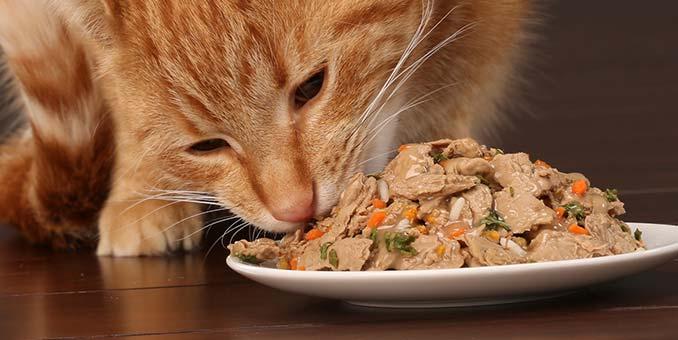
If you’re looking for a way to improve your furry friend’s health, nothing beats the benefits of a raw cat food diet. Raw cat food is packed with essential nutrients that are vital for your cat’s overall health and well-being.
One of the biggest advantages of feeding your cat raw food is that it contains high-quality proteins that help build strong muscles, bones, and tissues. In addition to this, raw cat food has higher nutritional value than commercial pet food as it isn’t processed or cooked at high temperatures which can destroy essential nutrients.
Feeding your cat a raw diet can also reduce the risk of obesity and other weight-related issues because it provides all the necessary vitamins and minerals without any added fillers or artificial preservatives. Moreover, cats with sensitive stomachs may also benefit from a raw diet as it eliminates any possible allergens present in commercial diets.
While there are certainly many health benefits associated with feeding your feline buddy a raw diet, there are also some potential risks involved. However, these risks can be minimized by following proper guidelines while preparing and storing raw meat.
With proper care and attention to detail, feeding your kitty a raw diet could prove beneficial in terms of their overall health and happiness.
Potential Risks of a Raw Cat Food Diet
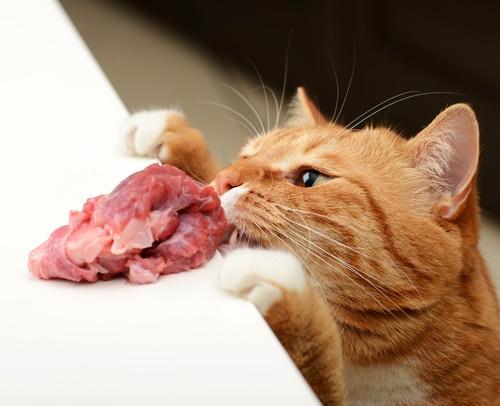
Beware of the dangers that lurk within a feline’s meal plan. While raw cat food has its benefits, there are also potential health concerns that shouldn’t be ignored. Here are three risks to consider:
Bacterial contamination: Since raw meat isn’t cooked, it may contain harmful bacteria like salmonella and E. coli that can make your cat sick. These bacteria can also spread to humans who handle the raw food or come into contact with their pet’s feces.Nutritional imbalances: Raw cat food diets can be difficult to balance properly, leading to nutritional deficiencies or excesses in certain vitamins and minerals. This can affect your cat’s overall health and potentially cause long-term damage if left unchecked.Potential for choking or obstruction: Bones in raw meat can pose a choking hazard for cats, especially if they’re not ground up enough before being fed. Additionally, large chunks of meat or bone can cause intestinal obstructions that require surgery to remove.
It’s important to weigh both the benefits and risks when considering a raw diet for your cat. While there are potential health concerns, many pet owners have found success with this type of feeding regimen when done correctly. In the next section, we’ll discuss how to choose the right raw ingredients for your feline friend’s diet without compromising their health and safety.
Choosing the Right Raw Ingredients
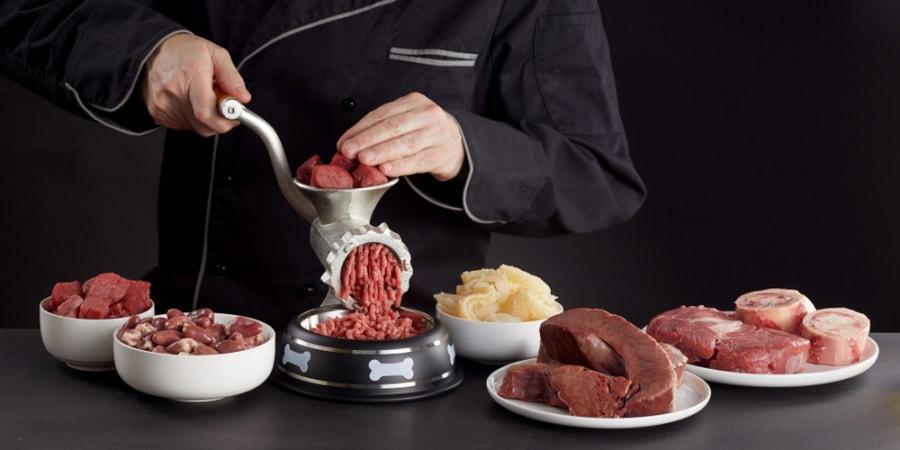
When selecting ingredients for your feline’s meal plan, it’s important to consider their nutritional needs and potential health risks. Nutritional balance should be a top priority when choosing raw food ingredients for your cat. This means sourcing meat that’s high in protein and low in fat, as well as incorporating other essential nutrients such as vitamins and minerals.
When sourcing meat, it’s important to choose high-quality, human-grade meats from reputable sources. This will help ensure that the meat is free of harmful contaminants such as bacteria or parasites that could pose a risk to your cat’s health. Additionally, incorporating variety into your cat’s diet can help ensure they are receiving a wide range of nutrients.
To prepare and store raw cat food safely, you must follow strict guidelines to avoid bacterial contamination. It’s recommended that you use stainless steel bowls and utensils when preparing the food and wash them thoroughly before each use. Store any unused portions of raw food in the refrigerator or freezer immediately after preparation to prevent spoilage.
Choosing the right raw ingredients for your feline’s diet is crucial for maintaining their overall health and wellbeing. By ensuring nutritional balance and sourcing high-quality meats from reputable sources, you can provide your cat with a nutrient-rich meal plan. However, it’s important to take precautions when preparing and storing raw cat food to prevent bacterial contamination.
Preparing and Storing Raw Cat Food
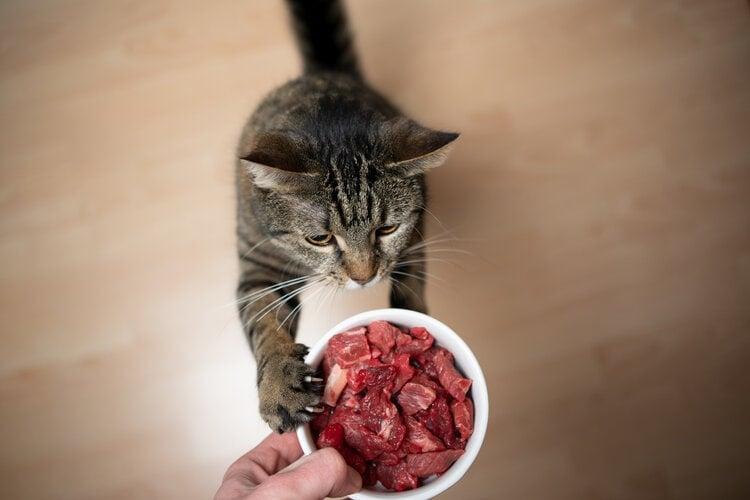
To ensure the safety of your furry friend, it’s important to follow proper guidelines for preparing and storing their meals. When preparing raw cat food, it’s crucial to use clean utensils and surfaces to avoid contamination. It’s also recommended to freeze meat for at least 48 hours before using it in your cat’s meals to kill any potential bacteria or parasites.
Meal prep is an essential step in ensuring your cat gets a balanced diet. You can portion out meals into individual servings and store them in airtight containers in the fridge or freezer. It’s best to only thaw enough portions for one day at a time in the refrigerator, as leaving raw meat at room temperature can cause bacterial growth.
Transitioning your cat to a raw food diet may take some patience and effort on your part, but it can lead to numerous health benefits for your furry friend. However, before making any changes to their diet, it’s always best to consult with your veterinarian first.
Transitioning Your Cat to a Raw Food Diet
Switching to a raw food diet for your feline friend can be a challenging but rewarding journey that promotes optimal health and vitality. Here are some transitioning tips to help make the process smoother:
Start slow: Gradually introduce raw food into your cat’s diet by mixing small amounts with their current food. Over time, increase the amount of raw food and decrease the amount of kibble until they are fully transitioned.Monitor your cat’s health: Keep an eye on your cat’s health during the transition period. Look out for any signs of discomfort or digestive issues such as vomiting or diarrhea. If you notice any negative changes, consult with your veterinarian immediately.Consult with your vet: Before starting a raw food diet, it’s important to consult with your vet to ensure that it’s appropriate for your cat’s individual needs and health history.Variety is key: Offer a variety of proteins and add in supplements such as omega-3 fatty acids, taurine, and vitamins to ensure that your cat is getting all the necessary nutrients.
Transitioning can take time, but it’s worth it in the end when you see improved energy levels, shinier coats, and overall better health in your furry friend. After successfully transitioning, you may want to consider exploring commercial raw cat food options, which offer convenience without sacrificing quality nutrition.
Commercial Raw Cat Food Options
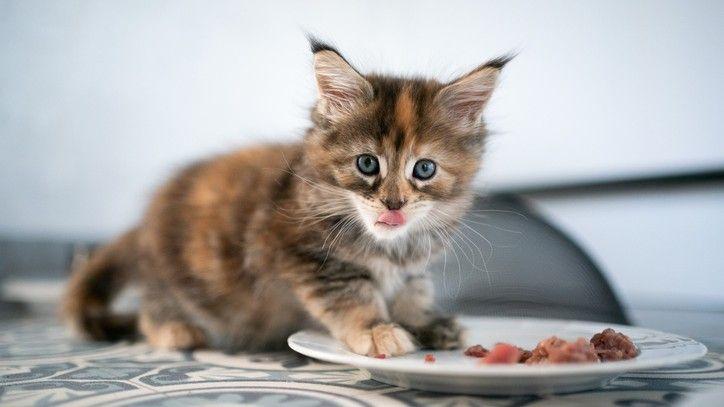
When it comes to transitioning your cat to a raw food diet, there are many commercial options available.
However, it’s important to consider both the pros and cons before making a decision.
To ensure that you choose a high-quality brand, be sure to read ingredient labels carefully and do your research on the company’s manufacturing practices.
Pros and Cons of Commercial Options
You can easily find commercial raw cat food options, but like a double-edged sword, they come with their own set of advantages and disadvantages.
On the one hand, commercial options may be more convenient and less time-consuming to prepare than homemade raw diets. Additionally, some brands offer a wider range of variety in terms of protein sources and additional supplements that could enhance your cat’s overall health. However, these benefits may come at a higher cost compared to preparing raw meals at home.
Furthermore, not all commercial options create equal when it comes to nutritional value. Some brands may have lower-quality ingredients or insufficient levels of essential nutrients for your cat’s specific needs. It’s important to do a cost comparison as well as research on the brand’s reputation and ingredient sourcing before choosing a high-quality option for your feline friend’s diet. This will ensure that you’re providing your pet with the best possible nutrition without breaking the bank or compromising their health in any way.
Choosing a High-Quality Brand
To ensure your feline friend receives optimal nutrition, it’s important to seek out a high-quality commercial brand that meets certain quality standards. Look for brands that use whole meats as the first ingredient, instead of by-products or fillers. Additionally, a good brand offers a variety of protein sources such as chicken, turkey, and beef, to provide your cat with a balanced diet.
When comparing prices between brands, keep in mind that higher prices may reflect better quality ingredients and better manufacturing processes. However, some premium brands overprice simply because of their marketing strategies. Do some research on the brand’s reputation and read reviews from other pet owners before making a decision.
Before we move on to reading ingredient labels, it’s essential to understand what sets high-quality cat food apart from lower-quality options. By looking for specific quality standards and doing research on pricing comparisons between brands, you can find a product that works best for both you and your furry friend.
Reading Ingredient Labels
Reading ingredient labels is essential for identifying the quality of commercial cat food brands. Understanding ingredients and label reading tips can help you make informed decisions about what to feed your feline friend.
When reading the label, start by looking at the first few ingredients listed. These are typically the main components of the food and should include a source of protein, such as chicken or fish.
Avoid foods with high levels of fillers, such as wheat or corn, which provide little nutritional value for cats.
It’s also important to pay attention to how much moisture is in the food – raw diets typically have higher moisture content than dry kibble. By taking these factors into consideration when reading ingredient labels, you can ensure that your cat is getting a high-quality diet that meets their nutritional needs.
Conclusion
In conclusion, transitioning your cat to a raw food diet can come with numerous benefits such as better digestion, healthier coat and skin, and increased energy. However, it’s important to note the potential risks that come with feeding your cat raw meat, such as bacterial infections and nutrient imbalances.
It’s crucial to choose high-quality raw ingredients and properly prepare and store them to ensure your cat’s safety. Remember, “you are what you eat”applies not only to humans but also our feline friends. By providing them with a well-balanced raw diet, you’re giving them the best chance at living a healthy life.
So, if you’ve decided to make the switch, take the time to do your research and consult with a veterinarian or animal nutritionist for guidance on how to create a balanced meal plan for your furry companion. As they say, “an ounce of prevention is worth a pound of cure.”
Read more:
How To Keep Your Feline Friend At A Healthy Cat Weight
